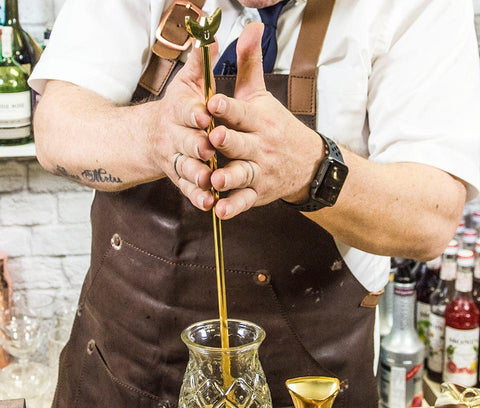
The swizzle stick. It’s got an interesting name and a simple structure. But what exactly is it and how should you be using it?
More to the point – what’s the difference between a good and a bad swizzle? After all, it’s just a stick! Or is it?
Originally, the swizzle stick was simply a stick with an added bit of… well, swizzle. They were made from wooden branches of the Caribbean tree, Quararibea Turbinata. The trees grow up to six metres tall and their long branches naturally take a forked or pronged shape, which makes the swizzle stick the unique bar tool that it is.
Nowadays, swizzle sticks are designed with a long stem and blades at the foot, imitating the original shape of the tree branch. The blades are used to churn the ingredients of specific cocktails – these cocktails have become known as swizzle cocktails and are making a real comeback.
There are three main styles of Caribbean swizzle, depending on which country of origin you pick – Guyana, Barbados or Trinidad – but the basics are always alcohol (think tropical, think rum!), angostura bitters and that all important crushed ice, making it the perfect summer sip.
So, do you really need a swizzle stick? Absolutely!
Swizzle cocktails are best made in a single glass – the ingredients and crushed ice go in and then the spinning motion of the stick causes aeration and dilution of the drink. Most the glass should get all frosted up in the process for that essential cooling effect.
As for the bartender, swizzling requires quite a bit of effort. The long stem of the swizzle stick is placed between the palm of the hands, with the blades in the drink. Then the drink is ‘swizzled’ using a fast, alternating, back-and-forth motion to swivel the stick between the palms of your hands (think boy scout using a stick to light a fire!).

As you can imagine, getting a good enough whisk going requires some quick and accurate handy work. An ergonomically designed swizzle stick will do its job as needed and take a lot of the effort out of swizzling those drinks – giving the bartender less work and the customer a better cocktail.
From its 19th century Tiki origins to the metal versions available now, this unique bar tool is an interesting and necessary addition to any bartender’s kit. And now Überbartools™ have teamed up with top bartenders, including Antonio Lai, to completely transform the humble swizzle stick into an impressive, fit-for-purpose range, including the new A-Swizz™ and LuxSwizz™.
These eye-catching swizzle sticks not only look good, but they’re all about durability and functionality. Ergonomically designed with the bartender in mind, they’re guaranteed to give you more swizzle, with less work, that’s fo’ shizzle!

